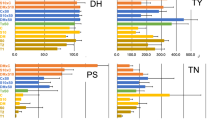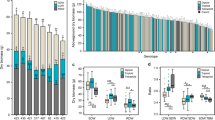Abstract
The 4x × 2x breeding scheme in potato allows introgression of germ-plasm from the 2x wild species into the cultivated tetraploid. Eighteen 4x × 2x, forty-five 4x × 4x, seven 4x-selfs, and five open pollinated (OP) families were transplanted in a randomized complete block design with two replications and 18 plants per family per replication. The 2x parents of the 4x × 2x families were seven haploid x wild species hybrids. These hybrids involve five 2x, wild species,Solanum bukasovii, S. gourlayi, S. muhidissectum, S. vermi, andS. verrucosum, which had not previously been evaluated in the 4x × 2x breeding scheme. Data were recorded for family yield, maturity, tuber uniformity, tuber number, and general tuber appearance. The 4x × 2x families as a group performed as well as or better than the 4x × 4x, 4x-self, and 4x-OP groups for all traits except maturity. Within family maturity distributions for 4x × 2x families indicate the possibility to select early maturing clones from high yielding families. Eleven of the fifteen families in the top 25% of the 4x × 2x and 4x × 4x families for yield were 4x × 2x families. Three of the four 2x parents evaluated for parental performance gave highly significant responses for increased yield. 4x × 2x families with Chiquita as a parent were the poorest yielding while several of the 4x x 4x families of which it was a parent were among the highest yielding: This indicates that the benefits of maximum heterozygosity may be overridden if the percentage of unadapted germplasm is too high.
Compendio
El programa 4x × 2x de mejoramiento en papa permite el pase de genes del germoplasma de las especies silvestres 2x en los tetraploides cultivados. Dieciocho 4x × 2x, cuarenticinco 4x × 4x, siete 4x autofecun-dados y cinco familias de polinización libre (PL) fueron trasplantados en un diseõ de bloques completamente al azar con dos repeticiones y 18 plantas por familia y por repetición. Los progenitores 2x de las familias 4x × 2x fueron siete híbridos haploide x especies silvestres. Estos híbridos incluían cinco especies silvestres 2x,Solanum bukasovii, S. gourlayi, S. multidissectum S. vermi, yS. verrucosum que no habían sido evaluadas anteriormente en el programa de mejoramiento 4x × 2x. Los datos registrados fueron el rendimiento por familia, maduración, uniformidad de tubérculo, número de tubérculos y apariencia general del tubérculo. Las familias 4x × 2x, como grupo, se comportaron tan bien o mejor que los grupos 4x × 4x, 4x autofecundados y 4x-PL para todas las características con excepción de la maduración. Dentro de la familia las distribuciones de la maduración para las familias 4x × 2x indican la posibilidad de seleccionar clones precoces de familias con alto rendimiento. Once de las quince familias en el 25% superior por rendimiento délas familias 4x × 2x y 4x × 4x fueron familias 4x × 2x. Tres de los cuatro progenitores 2x evaluados para comportamiento parental dieron respuestas altamente significativas en incrementos de rendimiento. Las familias 4x × 2x, con Chiquita como uno de los progenitores, fueron las de rendimientos más pobres mientras que varias de las familias 4x × 4x, de las cuales Chiquita era uno de los progenitores, estuvieron entre las de rendimientos más altos. Esto indica que los beneficios de una heterozigosis máxima pueden ser anulados si el porcentaje de germoplasma no adaptado es muy alto.
Similar content being viewed by others
Literature Cited
dejong, H. and G.C.C. Tai. 1977. Analysis of tetraploid-diploid hybrids in cultivated potatoes. Potato Res 20:111–121.
dejong, H., G.C.C. Tai, W.A. Russell, G.R. Johnston, and K.G. Proudfoot. 1981. Yield potential and genotype-environment interactions of tetraploid-diploid (4x-2x) potato hybrids. Am Potato J 58:191–199.
Douches, D.S. and C.F. Quiros. 1988. Additional isozyme loci in Tuber-bearing Solanums: Inheritance and linkage relationships. J Hered 79:377–384.
Hanneman, R.E., Jr. and J.B. Bamberg. 1986. Inventory of the tuber-bearingSolarium species. Wis Agrie Exp Stn Bull No 533.
Hermundstad, S.A. and S.J. Peloquin. 1985a. Male fertility and 2n pollen production in hapioid-wild species hybrids. Am Potato J 62:479–487.
Hermundstad, S.A. and S.J. Peloquin. 1985b. Germplasm enhancement with potato haploids. J Hered 76:463–467.
Hougas, R.W. and S J. Peloquin. 1962. ExploitationoÍ Solanum germ plasm.In: D.S. Correli. The potato and its wild relatives. Texas Research Foundation. Renner, Texas. 606 p.
Johnston, S.A., T.P.M. den Nijs, S.J. Peloquin and R.E. Hanneman, Jr. 1980. The significance of genie balance to endosperm development in interspecific crosses. Theor Appi Genet 61:161–169.
McHale, N.A. and F.I. Lauer. 1981. Breeding value of 2n pollen diploid from hybrids and Phureja in 4x-2x crosses in potatoes. Am Potato J 58:365–374.
Mendiburu, A.O. and S.J. Peloquin. 1977. The significance of 2n gametes in potato breeding. Theor Appi Genet 49:53–61.
Mok, D.W.S. and S.J. Peloquin. 1975. Breeding value of 2n pollen (diplandroids) in tetraploid x diploid crosses in potatoes. Theor Appi Genet 46:307–314.
Peloquin, S J. 1983. Genetic engineering with meiotic mutants.In: D.L. Mulcahy and E. Ottaviano (Eds.). Pollen: Biology and implications for plant breeding. 311-316 pp. Elsevier. New York.
Peloquin, S J., G.L. Yerk, J.E. Werner and E. Darmo. 1989. Breeding with haploids and 2n gametes. Genome 31:1000–1004.
Quinn, A.A. and S.J. Peloquin. 1973. Use of experimental tetraploids in potato breeding. Am Potato J 50:415–420.
Ross, H. 1986. Potato breeding-problems and perspectives. Verlag Paul Parey. Berlin. 132 p.
Rudorf, W. 1958. The significance of wild species for potato breeding. Eur Potato J 1:10–20.
Author information
Authors and Affiliations
Rights and permissions
About this article
Cite this article
Yerk, G.L., Peloquin, S.J. Performance of haploid x wild species, 2x hybrids (involving five newly evaluated species) in 4x × 2x families. American Potato Journal 67, 405–417 (1990). https://doi.org/10.1007/BF03044509
Accepted:
Published:
Issue Date:
DOI: https://doi.org/10.1007/BF03044509




